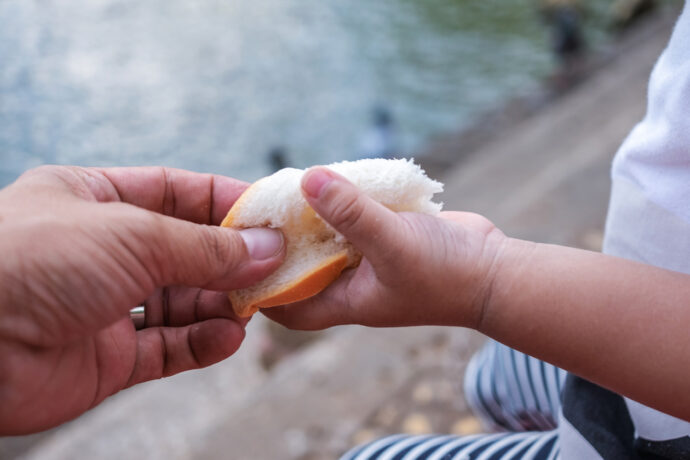Each week in our church we receive Communion, and it’s the part of the service that the children in our congregation look forward to most. It makes sense—children learn best in embodied ways, and Communion is a sacrament that engages all the senses.
A few weeks ago a young girl walked to the front, like normal. She received her piece of bread and dipped it deeply into the juice—but then she did something unexpected. Instead of hurrying to put it in her mouth before the juice dripped down her fingers, she divided her piece in half. I watched with curiosity as she bounced to the back of the sanctuary, where she then extended one of the pieces to her mother and ate the other piece herself. It was a beautiful moment—probably one she didn’t fully grasp—but this moment helped me recognize the truth that children so often are the ones extending us grace.
Our small, intergenerational church is no stranger to children. There are many weeks when children outnumber the adults in the sanctuary. They are present with their full selves—their loud, wiggly, excited, eager, rambunctious selves. We often have to explain to visitors that we are comfortable with disruption, that we are used to it, and that our view of church is as a large family with many members who are willing to step in when needed. I’ve often told the congregation that we are all worshiping and to remember that worship for children might look different than it does for adults.
Pope Francis declared while baptizing children in the Sistine chapel: “When a child cries in church, it is a beautiful homily.” Pope Francis is right. There is something beautiful about the sounds of children in church. The presence of children in our churches is a means of grace. Children teach us to care a little less about appearances. They teach us to worship with a bit more abandon. They teach us about being comfortable in a building when they don’t hesitate to sit down and take off their shoes, and sometimes their socks, in the middle of the sanctuary. Yet there is no shortness of wide-eyed wonder at the mystery of it all with children. They ask deep-hearted questions, and look at the stained-glass windows with awe. Children are a means of grace because they are just as much a part of this beautiful kingdom of God—this body of Christ—as the rest of us are. They are a deeply important and needed part of the church, so we embrace the chaotic moments, the cries, the wiggles, and the shouts—because, without them, we wouldn’t have a full picture of the kingdom of God
We are to be always receiving the grace of God and then looking around to see whom we can share it with.
In that moment, watching the little girl dividing and sharing her bread, I learned something about the kingdom of God—a homily greater than the sermon I preached that day. We are to be always receiving the grace of God and then looking around to see whom we can share it with. We are to be always reaching out to give a bit more to someone else. We are to be always willing to divide up the little bit we hold in our own hands to share with someone who holds less. There is a radical nature to this lesson of grace—there is no shortage, but always more to give, if we have the eyes to see and the willingness to open our hands. So I’m learning to look at my hands with the question “What grace do I hold, and how can I share it with others?”
Sometimes that grace is just an open hand to hold the hand of someone else through dark days. Sometimes that grace is the gift of laughter. Sometimes that grace is the gift of bread broken and divided. There is no shortage of grace, and we all have grace to offer the world, from the youngest among us to the oldest. So in these days, often hurried and busy, often dark and hard, may we take a moment to look at what our hands are holding, the grace within our grasp, and look around to see whom we can share it with, that we might taste and see that the Lord is good—together.





0 Comments